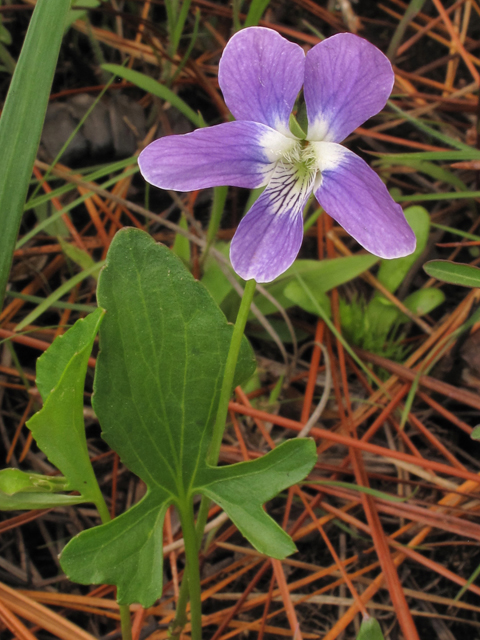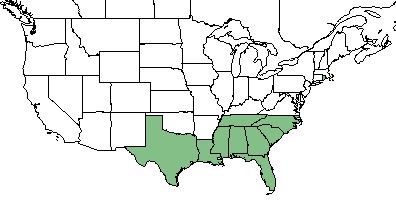Difference between revisions of "Viola septemloba"
(→Ecology) |
|||
| Line 27: | Line 27: | ||
==Ecology== | ==Ecology== | ||
===Habitat=== <!--Natural communities, human disturbed habitats, topography, hydrology, soils, light, fire regime requirements for removal of competition, etc.--> | ===Habitat=== <!--Natural communities, human disturbed habitats, topography, hydrology, soils, light, fire regime requirements for removal of competition, etc.--> | ||
| − | + | ''V. septemloba'' has been found in savannahs, creek margins, pine woods, and oak woodlands.<ref name="FSU"> Florida State University Herbarium Database. URL: http://herbarium.bio.fsu.edu. Last accessed: June 2021. Collectors: Loran C. Anderson, B. Boothe, M. Boothe, V Craig, and F. Griffith. States and counties: Florida: Franklin, Jefferson, Liberty, Taylor, and Washington.</ref> It is also found in disturbed areas including roadsides, lawns, and campsites.<ref name="FSU"/> Associated species: ''Hypoxis'' and ''Oxalis''.<ref name="FSU"/> ''Viola septemloba'' is an indicator species for the Panhandle Silty Longleaf Woodlands community type as described in Carr et al. (2010).<ref>Carr, S.C., K.M. Robertson, and R.K. Peet. 2010. A vegetation classification of fire-dependent pinelands of Florida. Castanea 75:153-189.</ref> | |
| − | ''V. septemloba'' has been found in savannahs, creek margins, pine woods, and oak woodlands.<ref name="FSU"> Florida State University Herbarium Database. URL: http://herbarium.bio.fsu.edu. Last accessed: June 2021. Collectors: Loran C. Anderson, B. Boothe, M. Boothe, V Craig, and F. Griffith. States and counties: Florida: Franklin, Jefferson, Liberty, Taylor, and Washington.</ref> It is also found in disturbed areas including roadsides, lawns, and campsites.<ref name="FSU"/> Associated species: ''Hypoxis'' and ''Oxalis''.<ref name="FSU"/> | ||
| − | |||
| − | ''Viola septemloba'' is an indicator species for the Panhandle Silty Longleaf Woodlands community type as described in Carr et al. (2010).<ref>Carr, S.C., K.M. Robertson, and R.K. Peet. 2010. A vegetation classification of fire-dependent pinelands of Florida. Castanea 75:153-189.</ref> | ||
<!--===Phenology===--> <!--Timing off flowering, fruiting, seed dispersal, and environmental triggers. Cite PanFlora website if appropriate: http://www.gilnelson.com/PanFlora/ --> | <!--===Phenology===--> <!--Timing off flowering, fruiting, seed dispersal, and environmental triggers. Cite PanFlora website if appropriate: http://www.gilnelson.com/PanFlora/ --> | ||
Revision as of 08:06, 24 June 2021
| Viola septemloba | |
|---|---|

| |
| Photo by Alan Cressler hosted at Wildflowers.org | |
| Scientific classification | |
| Kingdom: | Plantae |
| Division: | Magnoliophyta - Flowering plants |
| Class: | Magnoliopsida - Dicots |
| Order: | Violales |
| Family: | Violaceae |
| Genus: | Viola |
| Species: | v. septemloba |
| Binomial name | |
| Viola septemloba Leconte | |

| |
| Natural range of Viola septemloba from USDA NRCS Plants Database. | |
Contents
Taxonomic Notes
Synonyms: Viola palmata var. palmata; Viola palmata; Viola septemloba ssp. septemloba
Varieties: none
Description
Distribution
Ecology
Habitat
V. septemloba has been found in savannahs, creek margins, pine woods, and oak woodlands.[1] It is also found in disturbed areas including roadsides, lawns, and campsites.[1] Associated species: Hypoxis and Oxalis.[1] Viola septemloba is an indicator species for the Panhandle Silty Longleaf Woodlands community type as described in Carr et al. (2010).[2]
Conservation and Management
Cultivation and restoration
Photo Gallery
References and notes
- ↑ 1.0 1.1 1.2 Florida State University Herbarium Database. URL: http://herbarium.bio.fsu.edu. Last accessed: June 2021. Collectors: Loran C. Anderson, B. Boothe, M. Boothe, V Craig, and F. Griffith. States and counties: Florida: Franklin, Jefferson, Liberty, Taylor, and Washington.
- ↑ Carr, S.C., K.M. Robertson, and R.K. Peet. 2010. A vegetation classification of fire-dependent pinelands of Florida. Castanea 75:153-189.